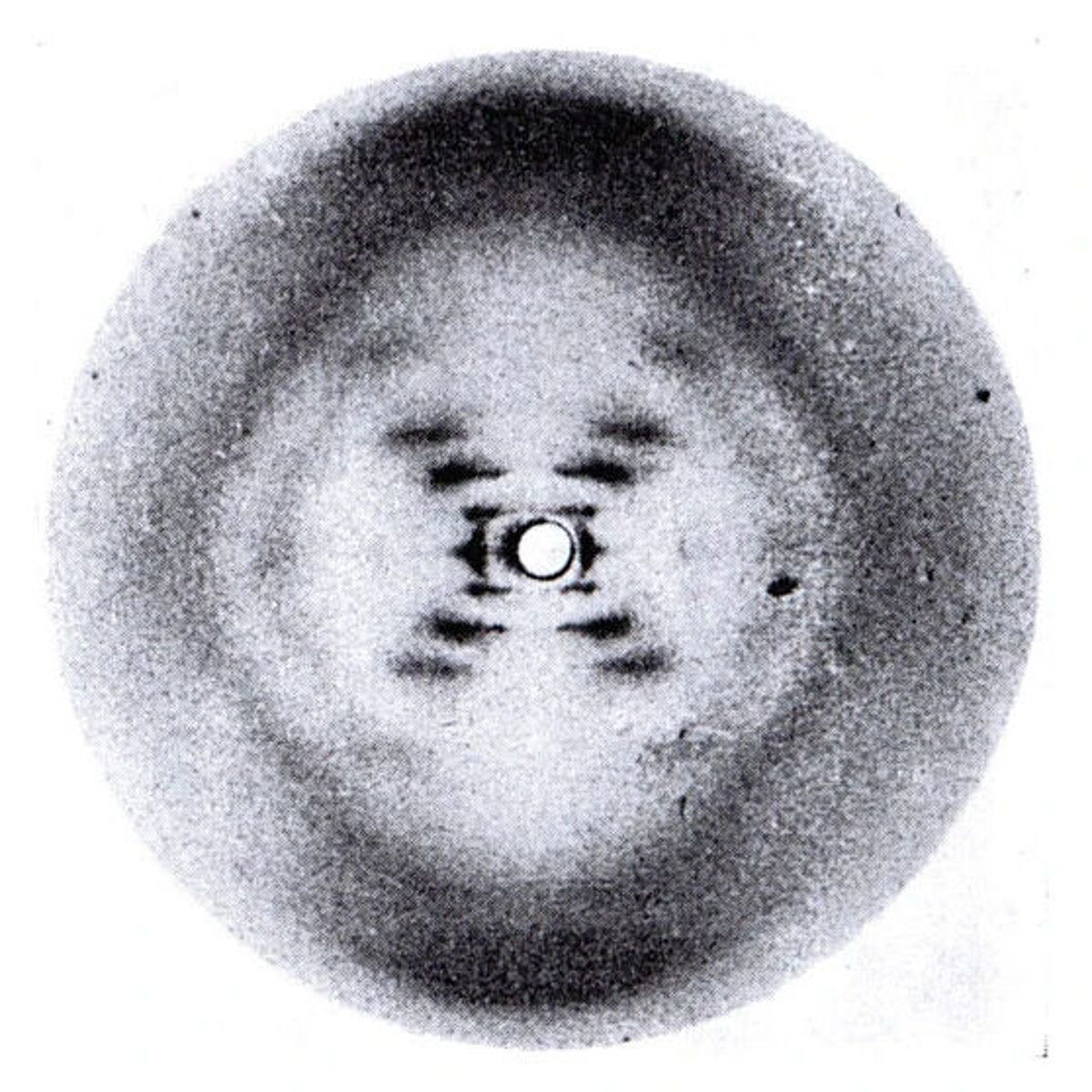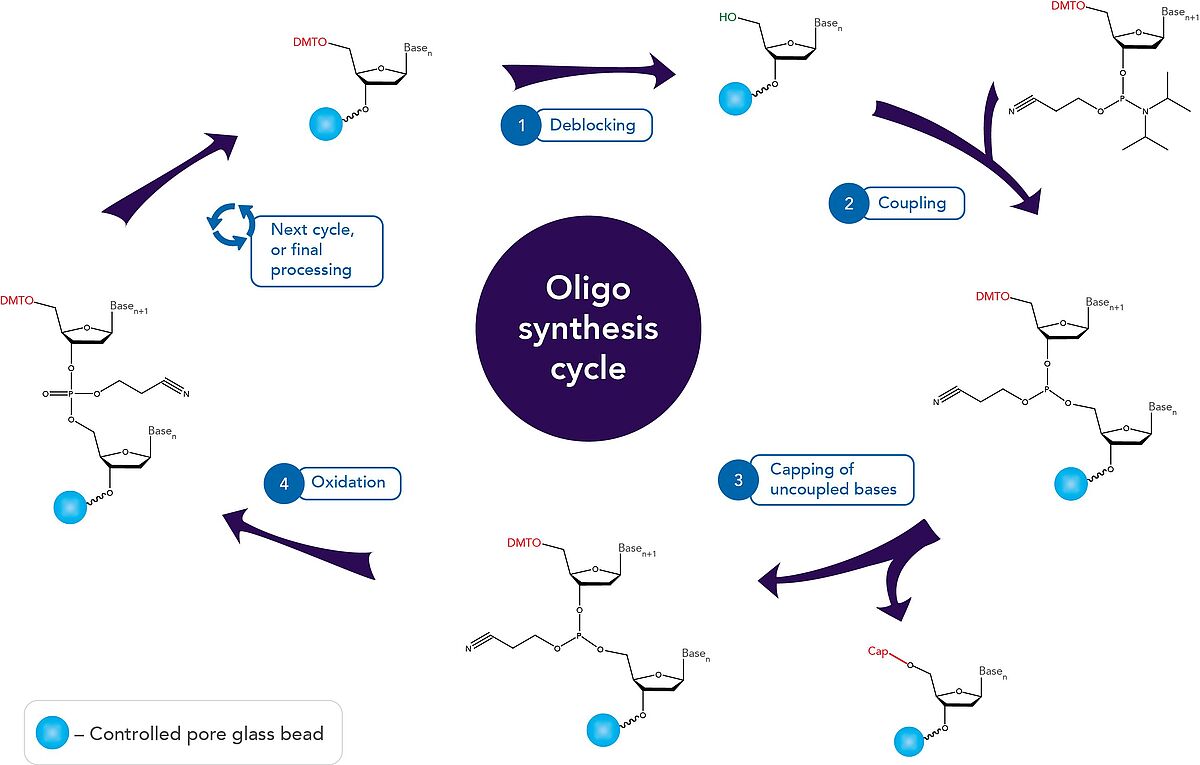What are oligos?
Oligos (or oligonucleotides) are short pieces of synthetic DNA or RNA — generally 20 to 100 nucleotides (nts) in length — although longer oligos serve specific functions. Employed in a myriad of applications, oligos are essential for next-generation sequencing (NGS), PCR cloning and diagnostic screening of diseases.
Origins of synthetic nucleic acids
In 1938, Warren Weaver from the Rockefeller Foundation coined the term "molecular biology". At the time, the term was used to describe the use of physical techniques to study living matter. Over the next few decades, the central tenets of molecular biology were established, describing how genetic information is carried to RNA and protein structures. By elucidating the double-helical structure of DNA using X-ray crystallography in 1953, Watson and Crick aided researchers in understanding how DNA replication occurred and laid the foundations for synthetic nucleic acid.

Image 1: J. D. Bernal, 1958. Franklin's X-ray diagram of the B form of sodium thymonucleate (DNA) fibres, published in Nature on 25 April 1953, shows “in striking manner the features characteristic of helical structures” [1]
Methods of oligo synthesis
Today, the gold standard in DNA synthesis is the phosphoramidite method, used by most nucleic acid synthesizers. Marvin H Caruthers initially described the phosphoramidite method in the early 1908s and later modified by solid-phase technology and automation. Solid-phase synthesis is advantageous over solution-phase synthesis, offering improved efficiency and faster production speeds.
Synthesized in the opposite direction to enzymatic DNA synthesis, chemical oligo synthesis proceeds in the 3'- to 5'- direction once the modified nucleotide is covalently attached to the solid support via its 3' carbon. The building blocks are chemically modified 2’-deoxynucleosides for DNA synthesis and ribonucleosides for RNA synthesis.
Nucleoside phosphoramidites are protected to prevent unwanted chemical reactions that hamper synthesis. These nucleosides are attached to the oligonucleotide to obtain the sequence of interest using a four-step cycle, including steps for deblocking, activation, capping and oxidation. Post-synthesis, processing steps release the oligo from the solid support. The end products can be purified using polyacrylamide gel electrophoresis (PAGE), high-performance liquid chromatography (HPLC), or both depending on length, sequence composition and characteristics of the oligo product.Oligos modified with tags and labels require alternative nucleotide building blocks and modifications in chemical synthesis steps.
Applications for oligos
Invented by Kary Mullis in the 1980s, PCR was the first application for oligos. Here oligos of approximately 18–24 nts in length are used to bind a target sequence and allow amplification of the target sequence, followed by cloning.
Quantitative PCR (qPCR) and qPCR combined with reverse transcriptase (RT) are used to monitor gene expression quantitatively using oligo probes. RT-PCR differs from qPCR in converting sample RNA to complementary DNA (cDNA) using a reverse transcriptase enzyme. PrimeTime primers/probes from LubioScience result in consistent PCR and qPCR performance.
For increased assay specificity, choose molecular beacon probes. These probes are dually labelled oligos contaning a quencher and fluorescent tag. In its native state, the oligo folds itself into a hairpin structure that quenches the fluorescence signal off-state. On binding the target sequence, these probes can emit fluorescence. These probes can be used in RT-PCR, endpoint PCR, SNP detection, and multiplex amplification.
Increased assay sensitivity and a reduction in the background can be achieved using longer, double-quenched probes (ZEN or TAO Double-Quenched Probes).

Oligos are also sequencing primers for next-generation sequencing (NGS) and probes for DNA microarray and fluorescence in situ Hybridization (FISH). Employing oligos for these applications is key in diagnosing various diseases, from detecting genetic abnormalities associated with cancer to infectious diseases.

Oligos are a key reagent in gene editing. Gene knockout can be achieved using chemically synthesized custom guide RNA for clustered regularly interspaced short palindromic repeats (CRISPR).

LubioScience provide the highest quality oligos on the market
Lubioscience works with the leader in oligosynthesis, Integrated DNA Technology (IDT). IDT synthesize oligonucleotides depending on the required modifications yield, length and application. IDT's high-quality range of research, diagnostic and good manufacturing practice (GMP) therapeutic-grade oligonucleotides are synthesized in small and large-scale quantities.
All single-stranded and duplexed DNA sequences are produced with the highest coupling efficiencies in the market, resulting in high-quality DNA products. IDT’s specialized platform allows to deliver primers for PCR, dual-labelled probes for qPCR, indexed adapters and fusion primers for sequencing, and a variety of custom products. With comprehensive quality control inspection procedures, including electrospray ionization (ESI) mass spectrometry and capillary electrophoresis, IDT ensure in-depth characterization of oligo products.
LubioScience provide several types of oligos, each designed for optimal performance depending on the application.
IDT
Integrated DNA Technologies (IDT) is your advocate for the genomics age. They produce tools for NGS, CRISPR, qPCR and PCR. Their products include DNA/RNA oligos, genes and gene fragments. For more than 30 years, IDT's innovative tools and solutions for genomics applications have been driving advances that inspire scientists to dream big and achieve their next breakthroughs.

References
- Image 1: Maddox, B. The double helix and the 'wronged heroine'. Nature 421, 407–408 (2003). https://doi.org/10.1038/nature01399
- Image 2: https://eu.idtdna.com/pages/education/decoded/article/oligo-synthesis-why-idt-leads-the-oligo-industry

